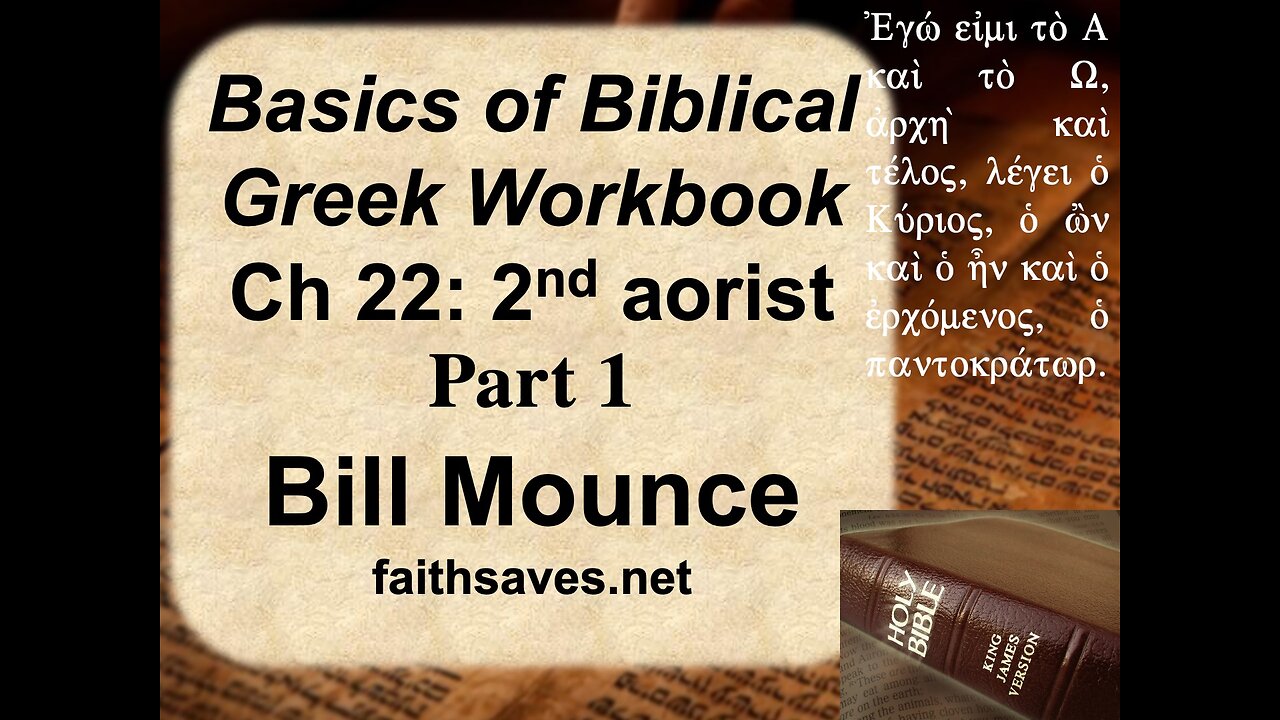Premium Only Content

New Testament / Koine Greek 29: Basics of Biblical Greek Workbook Ch 22 part 1: 2nd Aorist, Mounce
Lecture 29 in New Testament or Koine Greek covers chapter 22 of William (Bill) Mounce’s Basics of Biblical Greek Workbook, , the second aorist indicative verb. The lecturer is independent Baptist professor Thomas Ross. Both William D. Mounce, Basics of Biblical Greek (Workbook), ed. Verlyn D. Verbrugge, Third Edition. (Grand Rapids, MI: Zondervan, 2009) or William D. Mounce, Basics of Biblical Greek Workbook, Fourth Edition (Grand Rapids: Zondervan, 2019) would work for this class.
In chapter 22 of Basics of Biblical Greek (either the 3rd or the 4th edition) students learn the 2nd aorist indicative. The 2nd aorist stem tends to be exactly the same or very close in form to the root of the verb. The aorist indicates an undefined, snapshot, or summary action usually occurring in the past. This video covers the Basics of Biblical Greek Workbook for chapter 22, including all of the parsing and warmup exercises, as well as translation exercises 1-8. Please see the video covering part 2 of the workbook for the next section of Bill Mounce's workbook (video #30 in the first year Greek class). Portions of the following verses are translated:
α. Matthew 14:29
β. Matthew 14:15
γ. Revelation 12:4
δ. Acts 19:2
ε. John 8:53
ζ. Matthew 2:21
η. Luke 1:30
1. 1 Corinthians 15:3
2. Mark 14:16
3. Mark 1:11
4. Mark 9:38
5. Mark 10:18
6. Mark 1:35, 37
7. Mark 9:22
8. Markk 14:68.
The class session began with an examination of Revelation 6:12-17 and the question of the type of aorist that appears in Revelation 6:17's οτι ηλθεν η ημερα η μεγαλη της οργης αυτου. Does ηλθεν support a pretribulational Rapture, a prewrath Rapture, a mid-Trib Rapture, or some other position? Is the aorist constative, ingressive, gnomic, or proleptic? What connection does ηλθεν have with the ερχου και βλεπε refrain of Revelation 6:1, 3, 5 & 7? If the aorist in Revelation 6:17 is proleptic, it might undermine a pretribulation Rapture, but a constative aorist would lend support for the pretribulation view. Which type of aorist appears in the passage?
The constative aorist, which portrays summary past action, is much more common than a proleptic aorist. The English “whom he justified, them he also glorified” certainly shows that an “-ed” verb in English can be used for something that is yet future, because it is so certain to God, but how often do English-speakers portray action that way, in comparison to the frequency with which they employ the past tense to describe an event that is actually in the past? Assuming the aorist here portrays an action that has already started before this point is the natural assumption, rather than an assumption that God has not yet started to pour out His wrath in the first five seals.
Furthermore, Revelation 6:17 is not a statement that God makes; not a statement a holy angel makes; it is one the unregenerate earth-dwellers make, the same people who say things like “Who is like unto the beast? who is able to make war with him? (Revelation 13:4). If one concedes that wicked and unregenerate mankind now begins to understand that God’s wrath is being poured out, that does not mean that this point is when His wrath actually begins; as those who did not have all their thoughts set on God, they did not see His wrath in the famines, the plagues, the Antichrist, the wars, the death all around—but it actually already was God’s wrath, although they did not see it.
As Christ breaks each of the first four seals, a living creature or beast says, “come!” Then what happens? A judgment! The Antichrist takes power with the first seal, the rider on the white horse, conquering and to conquer; then the second seal, the wars after the short-lived peace of the Antichrist; then the world-wide famine of the third seal; then the death of 25% of the world’s population in the fourth seal. The fifth seal is obviously different, as we see there the martyred saints crying out for vengeance on the wicked, which God promises them He will enact. And then the sixth seal comes:
In Revelation 6:17 the expression “the day … has come” is an acknowledgment by all people in the context of the heavenly and earthly disturbances of 6:12–14 and the flight to the mountains and caves in 6:15–16. However, within the literary structure of this unit—the breaking of the seven seals—the “has come” (ēlthen) in the sixth vision is an acknowledgment of the results of the summons to come (erchou), which is repeated four times at the beginning of the series. The summons “come” calls forth elements of the day of the Lord. The declaration “has come” looks back over all these elements and acknowledges what has in fact come to be.
This usage also suits Old Testament Day of the Lord prophecies.
So in Revelation 6:17 even the unregenerate earth-dwellers finally recognize what has been going on since the first seal—the wrath of God poured out upon the earth, wrath which started with the first seal—the pre-Tribulation Rapture.
-
 12:51
12:51
Dr. Nick Zyrowski
5 hours agoDoctors Got It Wrong! How to RAISE Testosterone Levels Forever
3201 -
 1:14:40
1:14:40
Mark Kaye
3 hours ago🔴 Trump FUMES As Police Abandon Chicago At Pritzker's Orders
3.05K5 -
 56:24
56:24
DeVory Darkins
2 hours ago $23.59 earnedFederal Judge issues shocking order against Trump as Chicago Mayor pulls insane stunt
58.8K106 -
 1:24:59
1:24:59
Sean Unpaved
2 hours agoPoll Plunge & Mile-High Mayhem: Texas & Penn State Crash, Sunday's Fireworks, & Broncos Stun Eagles'
15.2K -
 9:24
9:24
Ken LaCorte: Elephants in Rooms
1 day ago $0.12 earnedThe secret of Indian store owners
1062 -
 8:30
8:30
Millionaire Mentor
23 hours agoJames Comey PANICS After Pam Bondi Reveals What’s Coming Next
3006 -
 LIVE
LIVE
Jeff Ahern
44 minutes agoMonday Madness with Jeff Ahern
81 watching -
 8:07
8:07
Michael Heaver
4 hours agoBritain CANNOT Afford To Ignore This
39 -
 2:55:02
2:55:02
Right Side Broadcasting Network
5 hours agoLIVE REPLAY: White House Press Secretary Karoline Leavitt Holds a Press Briefing - 10/6/25
79.9K13 -
 1:00:32
1:00:32
Dear America
2 hours agoEp 4 Graham Allen Show
21.5K15
